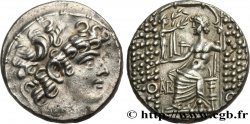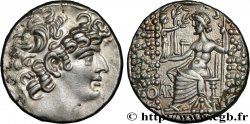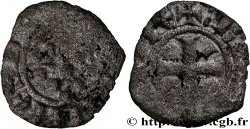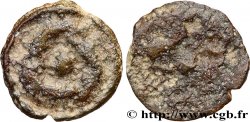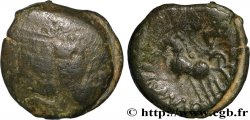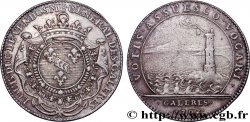- Accueil
- >
- >
Precedente 1/1
Live auction - bpv_349868 - SYRIA - ROMAN PROVINCE - AULUS GABINUS Tétradrachme syro-phénicien
Devi Sign-in ed essere un offerente approvato fare un'offerta, Login per fare offerte. Conti sono soggetti ad approvazione e di approvazione sono raggiunti entro 48 ore. Non aspettare fino al giorno di una vendita si chiude per registrarti.Confermando la tua offerta su questo oggetto ti impegni ad un contratto legalmente vincolante per l'acquisto di questo prodotto e fare clic su «offerta» costituisce accettazione dei termini di utilizzo de live auctions cgb.fr.
Offerta deve essere collocato in euro gli importi interi vendita only.The si chiuderà al momento sulla descrizione dell'oggetto, eventuali offerte pervenute al sito dopo l'orario di chiusura non verranno eseguite. Volte transmition possono variare e le offerte potrebbero essere respinto se si attende per gli ultimi secondi. Per ulteriori informazioni ckeck le FAQ Live auction.
Le offerte vincenti saranno sottomesse ai 18% per spese di compartecipazione alla vendita.
Le offerte vincenti saranno sottomesse ai 18% per spese di compartecipazione alla vendita.
| Valutazione : | 850 € |
| Prezzo : | 620 € |
| Offerta maxima : | 630 € |
| Data di fine vendita : | 31 marzo 2015 14:12:20 |
| partecipanti : | 3 partecipanti |
Tipo : Tétradrachme syro-phénicien
Data: 57-55 AC.
Nome della officina / città: Antioche, Syrie, Séleucie et Piérie
Metallo : argento
Diametro : 26,5 mm
Asse di coniazione : 12 h.
Peso : 15,24 g.
Grado di rarità : R1
Commenti sullo stato di conservazione:
Exemplaire sur un flan ovale bien centré des deux côtés. Très belle tête de style hellénisant. Revers de style fin. Très jolie patine de collection ancienne avec des reflets dorés. Conserve la plus grande partie de son brillant de frappe et de son coupant d’origine
N° nelle opere di riferimento :
Diritto
Titolatura diritto : ANÉPIGRAPHE.
Descrittivo diritto : Tête diadémée de Philippe Philadelphe à droite, entouré de la stemma.
Rovescio
Descrittivo rovescio : Zeus nicéphore assis à gauche sur un trône avec dossier, tenant une Niké de la main droite et un sceptre long de la main gauche ; monogramme dans le champ à gauche.
Legenda rovescio : BASILEWS/ FILIPPOU/ EPIFANOUS/ FILADELFOU
Commento
Première frappe romaine en argent dans la région, commence la série des tétradrachmes au type de Philippe Philadelphe.
On attribue cette frappe à partir du monogramme du revers qui se lit AVB pour Aulus Gabinius. Général et homme politique, voir l’article de wikipedia le concernant à http://fr.wikipedia.org/wiki/Aulus_Gabinius , il assurera le pouvoir romain dans la région.
Avec cette monnaie, c’est une ère nouvelle qui commence et qui clôt pour le Proche-Orient le chapitre ouvert par les conquêtes d’Alexandre.
Les émissions au type immobilisé de Philippe Philadelphe sont très importantes car elles illustrent parfaitement la logique impériale de la colonisation romaine. Autant une conquête de revendication territoriale d'expansion de l'espace vital autour d'un pouvoir central de type national va chercher à éliminer toutes les symboliques locales dans les pays conquis pour imposer celles du conquérant (selon le principe de un peuple, un roi, une foi, une loi), autant un empire va laisser cohabiter des symboliques différentes. C'est ce qui se passe en Syrie, Palestine et Phénicie dans les premiers temps de l'expansion. Loin d'imposer le denier ou la typologie romaine, les Latins vont respecter la métrologie et même le type. Il faudra attendre les rares émissions d'Auguste au revers du Zeus, presque cinquante ans, pour voir apparaître le portrait du Prince sur les monnaies locales en argent.
Style classique pour l’émission avec les mèches traitées en “serpents”. On remarquera le style du plissé de l’himation de Zeus que nous retrouverons exactement dans la première émission au portrait d’Auguste.
Dans la base TSP que maintenait par Michel Prieur, soixante dix-neuf exemplaires étaient répertoriés.
First Roman silver strike in the region, begins the series of tetradrachms of the type of Philip Philadelphus.
This strike is attributed from the monogram on the reverse which reads AVB for Aulus Gabinius. General and politician, see the Wikipedia article about him at http://fr. Wikipedia. org/wiki/Aulus_Gabinius, he will ensure Roman power in the region.
With this coin, a new era begins and closes for the Near East the chapter opened by the conquests of Alexander..
The immobilized type emissions of Philippe Philadelphe are very important because they perfectly illustrate the imperial logic of Roman colonization.. Just as a conquest of territorial claim of expansion of the living space around a central power of national type will seek to eliminate all local symbols in the conquered countries to impose those of the conqueror (according to the principle of one people, one king, one faith, one law), so an empire will allow different symbols to coexist. This is what happened in Syria, Palestine and Phoenicia in the early days of expansion.. Far from imposing the denarius or Roman typology, the Latins will respect metrology and even the type. It was not until the rare issues of Augustus on the reverse of the Zeus, almost fifty years later, that the portrait of the Prince appeared on local silver coins..
Classic style for the show with the strands treated in “snakes”. We will notice the style of the pleating of the himation of Zeus that we will find exactly in the first emission with the portrait of Augustus.
In the TSP database maintained by Michel Prieur, seventy-nine examples were listed.
On attribue cette frappe à partir du monogramme du revers qui se lit AVB pour Aulus Gabinius. Général et homme politique, voir l’article de wikipedia le concernant à http://fr.wikipedia.org/wiki/Aulus_Gabinius , il assurera le pouvoir romain dans la région.
Avec cette monnaie, c’est une ère nouvelle qui commence et qui clôt pour le Proche-Orient le chapitre ouvert par les conquêtes d’Alexandre.
Les émissions au type immobilisé de Philippe Philadelphe sont très importantes car elles illustrent parfaitement la logique impériale de la colonisation romaine. Autant une conquête de revendication territoriale d'expansion de l'espace vital autour d'un pouvoir central de type national va chercher à éliminer toutes les symboliques locales dans les pays conquis pour imposer celles du conquérant (selon le principe de un peuple, un roi, une foi, une loi), autant un empire va laisser cohabiter des symboliques différentes. C'est ce qui se passe en Syrie, Palestine et Phénicie dans les premiers temps de l'expansion. Loin d'imposer le denier ou la typologie romaine, les Latins vont respecter la métrologie et même le type. Il faudra attendre les rares émissions d'Auguste au revers du Zeus, presque cinquante ans, pour voir apparaître le portrait du Prince sur les monnaies locales en argent.
Style classique pour l’émission avec les mèches traitées en “serpents”. On remarquera le style du plissé de l’himation de Zeus que nous retrouverons exactement dans la première émission au portrait d’Auguste.
Dans la base TSP que maintenait par Michel Prieur, soixante dix-neuf exemplaires étaient répertoriés.
First Roman silver strike in the region, begins the series of tetradrachms of the type of Philip Philadelphus.
This strike is attributed from the monogram on the reverse which reads AVB for Aulus Gabinius. General and politician, see the Wikipedia article about him at http://fr. Wikipedia. org/wiki/Aulus_Gabinius, he will ensure Roman power in the region.
With this coin, a new era begins and closes for the Near East the chapter opened by the conquests of Alexander..
The immobilized type emissions of Philippe Philadelphe are very important because they perfectly illustrate the imperial logic of Roman colonization.. Just as a conquest of territorial claim of expansion of the living space around a central power of national type will seek to eliminate all local symbols in the conquered countries to impose those of the conqueror (according to the principle of one people, one king, one faith, one law), so an empire will allow different symbols to coexist. This is what happened in Syria, Palestine and Phoenicia in the early days of expansion.. Far from imposing the denarius or Roman typology, the Latins will respect metrology and even the type. It was not until the rare issues of Augustus on the reverse of the Zeus, almost fifty years later, that the portrait of the Prince appeared on local silver coins..
Classic style for the show with the strands treated in “snakes”. We will notice the style of the pleating of the himation of Zeus that we will find exactly in the first emission with the portrait of Augustus.
In the TSP database maintained by Michel Prieur, seventy-nine examples were listed.







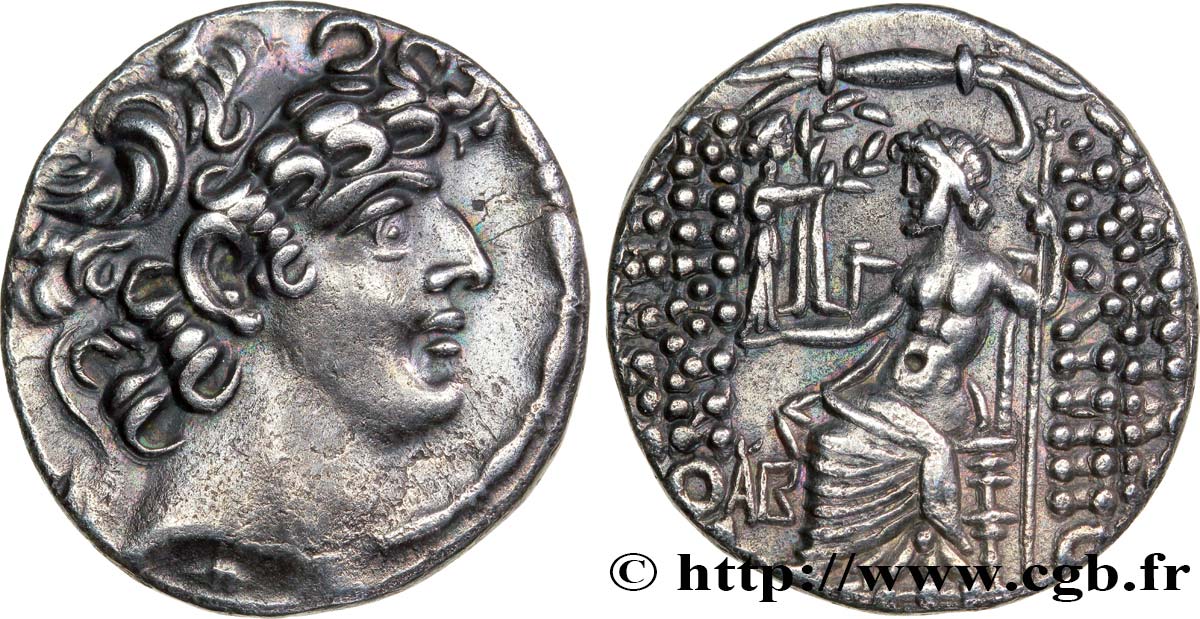
 Segnalare un errore
Segnalare un errore Stampate la pagina
Stampate la pagina Condividi mia selezione
Condividi mia selezione Fai una domanda
Fai una domanda Consegnare / vendere
Consegnare / vendere
 Descrittivo
Descrittivo
